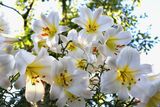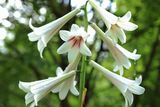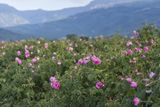Mind the gap with meadow rue
Meadow rue is an excellent addition to the garden
The early summer-flowering meadow rue is a really good addition to the garden. There is a bit of a colour gap in many gardens and borders in this transition period between late spring and early summer. A few plant species are invaluable, including peonies, Oriental poppies and irises, and to that group can be added the early forms of meadow rue, or thalictrum.
It gets the name meadow rue because of the small leaf-lets on the leaves, rounded and reminiscent of rue, a little shrubby herb once used in herbal medicine. Thalictrum grows in meadows in Europe and its leaves are also like those of columbine, or aquilegia, which gives the botanical name of Thalictrum aquilegifolium, another good early-summer flower, and they are both members of the buttercup family. So, both the common name and the botanical name allude to the leaf shape. The flower heads of thalictrum, which is in full flower at the moment, are almost like candy floss, a mass of filamentous pistils and stamens, the flower's fertile parts, but no coloured petals. The floss of filaments has a soft pale purple colour, made more gentle and dreamy by the sheer numbers of tiny flower parts. Each tiny flower is made up of a puff of filaments, opening from rounded buds, carried on a strong branching flower stem. In natural conditions, the flower stem would reach up to one metre above the grasses of a meadow. In a border, it lifts the gauzy flowers clear of developing summer perennials, getting in ahead of the crowd. While the pale purple kind is more often seen, there is a very pretty white-flowered version.
There are some other kinds that open into flower later. The yellow meadow rue has lemon-yellow flowers, held more in clumps than the fluffy candyfloss look of the early summer kind. Later in summer, the very beautiful Chinese meadow rue, Thalictrum delavayi, comes into flower in shades of light purple or white. This species is a bit taller and very elegant. It has fewer filaments in each flower making them more airy in appearance, not as much of a candyfloss look.
Thalictrums are easy to grow. They are natural moist meadow plants and like moist soil, not wet or waterlogged, and plenty of organic material in the soil. They are hardy, not damaged by frost. Best results are achieved if the plants are lifted, divided and replanted every few years, but good feeding with organic material will also help to increase the size of the fluffy flowers.
Help! My viburnum is turning yellow!
Q "I planted a healthy Viburnum rhytidophyllum one month ago and its leaves are turning yellow. No frost since planting, acid clay soil. I put plenty of my own compost and an appropriate quantity of blood, fish and bone in the planting hole and watered well. Mulched with my own compost and watered when needed." W Cunningham, Donegal
A Young plants are often soft when new from the nursery and can show signs of stress while they adapt to their new conditions. It is likely to grow away fine if the ground is not wet, which causes root-rot disease. Allow the soil to dry a little between waterings to encourage root growth.
Send your questions to gerrydaly@independent.ie. Questions can only be answered on this page.
Join the Irish Independent WhatsApp channel
Stay up to date with all the latest news














